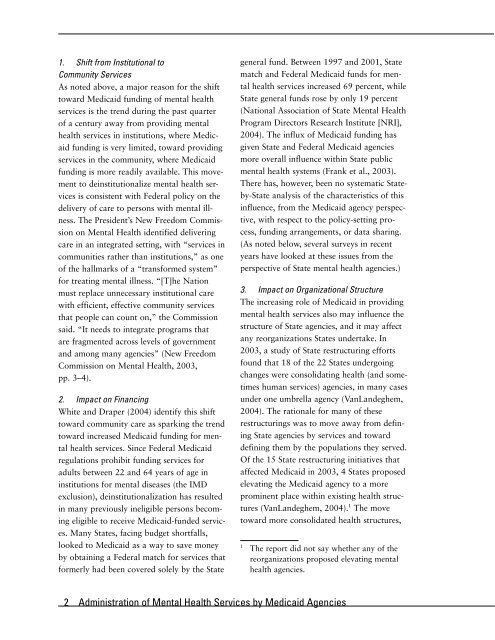Administration of Mental Health Services by Medicaid Agencies
Administration of Mental Health Services by Medicaid Agencies
Administration of Mental Health Services by Medicaid Agencies
Create successful ePaper yourself
Turn your PDF publications into a flip-book with our unique Google optimized e-Paper software.
1. Shift from Institutional toCommunity <strong>Services</strong>As noted above, a major reason for the shifttoward <strong>Medicaid</strong> funding <strong>of</strong> mental healthservices is the trend during the past quarter<strong>of</strong> a century away from providing mentalhealth services in institutions, where <strong>Medicaid</strong>funding is very limited, toward providingservices in the community, where <strong>Medicaid</strong>funding is more readily available. This movementto deinstitutionalize mental health servicesis consistent with Federal policy on thedelivery <strong>of</strong> care to persons with mental illness.The President’s New Freedom Commissionon <strong>Mental</strong> <strong>Health</strong> identified deliveringcare in an integrated setting, with “services incommunities rather than institutions,” as one<strong>of</strong> the hallmarks <strong>of</strong> a “transformed system”for treating mental illness. “[T]he Nationmust replace unnecessary institutional carewith efficient, effective community servicesthat people can count on,” the Commissionsaid. “It needs to integrate programs thatare fragmented across levels <strong>of</strong> governmentand among many agencies” (New FreedomCommission on <strong>Mental</strong> <strong>Health</strong>, 2003,pp. 3–4).2. Impact on FinancingWhite and Draper (2004) identify this shifttoward community care as sparking the trendtoward increased <strong>Medicaid</strong> funding for mentalhealth services. Since Federal <strong>Medicaid</strong>regulations prohibit funding services foradults between 22 and 64 years <strong>of</strong> age ininstitutions for mental diseases (the IMDexclusion), deinstitutionalization has resultedin many previously ineligible persons becomingeligible to receive <strong>Medicaid</strong>-funded services.Many States, facing budget shortfalls,looked to <strong>Medicaid</strong> as a way to save money<strong>by</strong> obtaining a Federal match for services thatformerly had been covered solely <strong>by</strong> the Stategeneral fund. Between 1997 and 2001, Statematch and Federal <strong>Medicaid</strong> funds for mentalhealth services increased 69 percent, whileState general funds rose <strong>by</strong> only 19 percent(National Association <strong>of</strong> State <strong>Mental</strong> <strong>Health</strong>Program Directors Research Institute [NRI],2004). The influx <strong>of</strong> <strong>Medicaid</strong> funding hasgiven State and Federal <strong>Medicaid</strong> agenciesmore overall influence within State publicmental health systems (Frank et al., 2003).There has, however, been no systematic State<strong>by</strong>-Stateanalysis <strong>of</strong> the characteristics <strong>of</strong> thisinfluence, from the <strong>Medicaid</strong> agency perspective,with respect to the policy-setting process,funding arrangements, or data sharing.(As noted below, several surveys in recentyears have looked at these issues from theperspective <strong>of</strong> State mental health agencies.)3. Impact on Organizational StructureThe increasing role <strong>of</strong> <strong>Medicaid</strong> in providingmental health services also may influence thestructure <strong>of</strong> State agencies, and it may affectany reorganizations States undertake. In2003, a study <strong>of</strong> State restructuring effortsfound that 18 <strong>of</strong> the 22 States undergoingchanges were consolidating health (and sometimeshuman services) agencies, in many casesunder one umbrella agency (VanLandeghem,2004). The rationale for many <strong>of</strong> theserestructurings was to move away from definingState agencies <strong>by</strong> services and towarddefining them <strong>by</strong> the populations they served.Of the 15 State restructuring initiatives thataffected <strong>Medicaid</strong> in 2003, 4 States proposedelevating the <strong>Medicaid</strong> agency to a moreprominent place within existing health structures(VanLandeghem, 2004). 1 The movetoward more consolidated health structures,1The report did not say whether any <strong>of</strong> thereorganizations proposed elevating mentalhealth agencies.2<strong>Administration</strong> <strong>of</strong> <strong>Mental</strong> <strong>Health</strong> <strong>Services</strong> <strong>by</strong> <strong>Medicaid</strong> <strong>Agencies</strong>
















